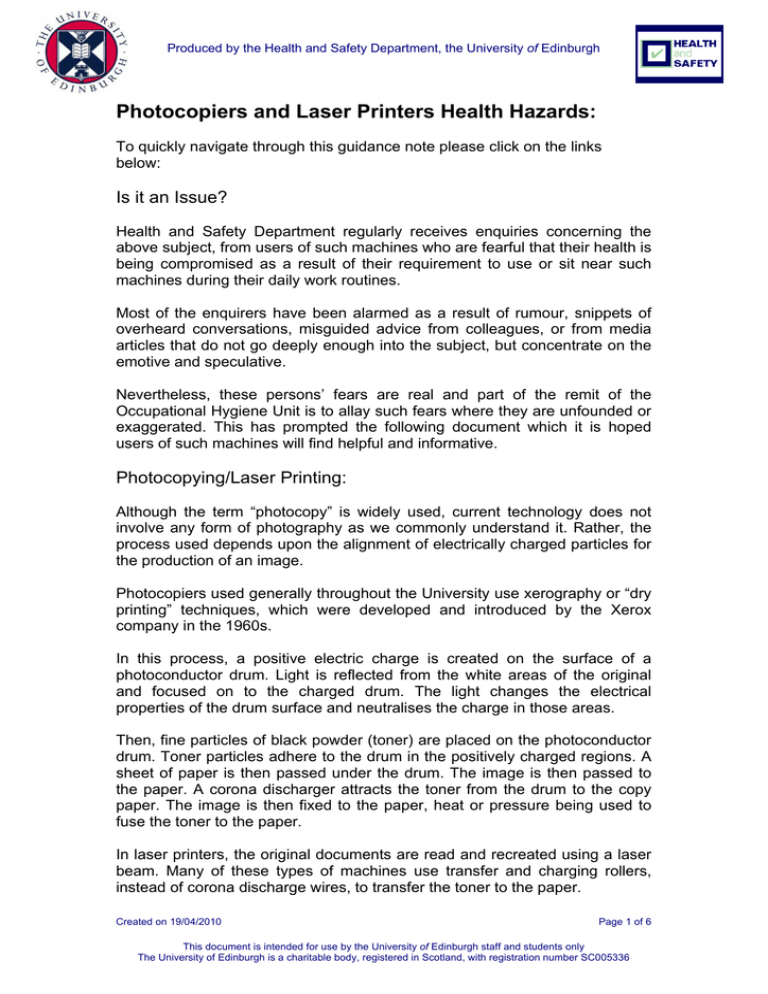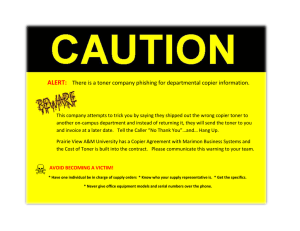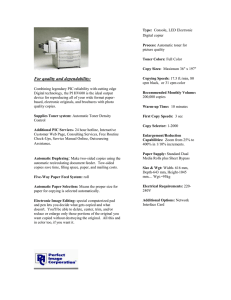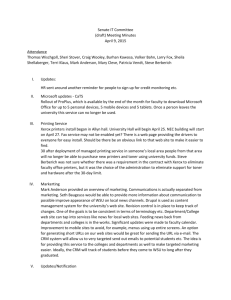Photocopiers and Laser Printers Health Hazards
advertisement

Produced by the Health and Safety Department, the University of Edinburgh Photocopiers and Laser Printers Health Hazards: To quickly navigate through this guidance note please click on the links below: Is it an Issue? Health and Safety Department regularly receives enquiries concerning the above subject, from users of such machines who are fearful that their health is being compromised as a result of their requirement to use or sit near such machines during their daily work routines. Most of the enquirers have been alarmed as a result of rumour, snippets of overheard conversations, misguided advice from colleagues, or from media articles that do not go deeply enough into the subject, but concentrate on the emotive and speculative. Nevertheless, these persons’ fears are real and part of the remit of the Occupational Hygiene Unit is to allay such fears where they are unfounded or exaggerated. This has prompted the following document which it is hoped users of such machines will find helpful and informative. Photocopying/Laser Printing: Although the term “photocopy” is widely used, current technology does not involve any form of photography as we commonly understand it. Rather, the process used depends upon the alignment of electrically charged particles for the production of an image. Photocopiers used generally throughout the University use xerography or “dry printing” techniques, which were developed and introduced by the Xerox company in the 1960s. In this process, a positive electric charge is created on the surface of a photoconductor drum. Light is reflected from the white areas of the original and focused on to the charged drum. The light changes the electrical properties of the drum surface and neutralises the charge in those areas. Then, fine particles of black powder (toner) are placed on the photoconductor drum. Toner particles adhere to the drum in the positively charged regions. A sheet of paper is then passed under the drum. The image is then passed to the paper. A corona discharger attracts the toner from the drum to the copy paper. The image is then fixed to the paper, heat or pressure being used to fuse the toner to the paper. In laser printers, the original documents are read and recreated using a laser beam. Many of these types of machines use transfer and charging rollers, instead of corona discharge wires, to transfer the toner to the paper. Created on 19/04/2010 Page 1 of 6 This document is intended for use by the University of Edinburgh staff and students only The University of Edinburgh is a charitable body, registered in Scotland, with registration number SC005336 Produced by the Health and Safety Department, the University of Edinburgh The Sources of Possible Health Concerns - Toner, Carbon Black, Polymer Resin, Ozone, Light and Ultraviolet Light, Noise and Heat, Laser Beam Toner: Photocopiers and laser printers use toner as part of the printing process. The toner is an extremely fine powder, which in itself is not classed as a substance hazardous to health, but any dust in substantial concentration is, as it may cause respiratory tract irritation resulting in coughing and sneezing. Toner dust may become airborne for a variety of reasons; toner dust spilled inside the machine becomes airborne by passing through the ventilation fans into the room, the waste toner compartment fills up and causes toner to back up inside the machine, or the most common, careless renewal of the toner cartridge causes a spill of toner into the room. Toner dust is considered a nuisance dust and should have no health effects other than those noted above. However, persons who have an already compromised respiratory system (e.g. suffer from asthma, bronchitis, etc) should avoid changing toner cartridges. If this is not practicable then the operation should be carried out with extreme caution to avoid generating a dust cloud. Should any toner be spilt, it is best to vacuum up, rather than brush off, as much as possible to avoid raising a dust cloud. The remainder should be removed using a damp cloth rinsed in cold water. Hot water should be avoided as it may cause the toner to partially melt and become sticky. Toner may be disposed of as normal waste, though it should be placed in a sealed bag to contain the fine powder. Carbon Black: Up to 7% of the toner may be composed of carbon black. Carbon black became a cause for concern when a group of Swedish scientists noticed that certain toners caused genetic changes in bacterial test systems. After this was noticed, the manufacturers of carbon black changed their process. Since then, numerous studies have been carried out to determine the effects of exposure to carbon black. In all instances, there was no evidence of cancer production and no unusual death rates. The small content of carbon black is therefore not a cause for concern. Polymer Resin: The image fixing of the final copy uses a low melt polymer resin; this varies in its composition dependant on the manufacturer. The heat required for this process is just sufficient to melt the resin and vapour produced is minimal and insignificant. Ozone: The consequences of exposure to concentrations of ozone is the most common concern amongst users of photocopiers and laser printers. It was Created on 19/04/2010 Page 2 of 6 This document is intended for use by the University of Edinburgh staff and students only The University of Edinburgh is a charitable body, registered in Scotland, with registration number SC005336 Produced by the Health and Safety Department, the University of Edinburgh therefore considered appropriate to give a more general overview of ozone, its occurrence and properties, in addition to its possible effects on health in relation to working with photocopiers and laser printers. Ozone, O3, a form of oxygen, is a normal constituent of the earth’s atmosphere. It is a highly reactive, unstable, colourless gas with a distinctive odour which, at room temperature, decomposes rapidly to oxygen, O2, particularly on contact with furnishings. Ozone cannot be stored or transported in vessels because it decomposes in the presence of oxidisible impurities, humidity and solid surfaces. As ozone is such a highly reactive substance, any adverse health effects will be found essentially at the sites of initial contact; the respiratory tract (nose, throat and airways), the lungs and at higher concentrations, the eyes. The principle health affects are produced by irritation of and damage to the small airways of the lung. Ozone is produced naturally from oxygen whenever sufficient ultraviolet (UV) radiation or electrical discharges occur e.g. the action of lightning or by photo chemical reactions involving oxides of nitrogen and hydrocarbons. Ozone is produced industrially by bombarding oxygen with UV radiation or by passing air through a high voltage AC electrical discharge. Uses include; improving air quality in offices, odour suppresser in hotel bedrooms, commercial kitchens, cafeterias and food processing plants, as a disinfectant in drinking water production, swimming pools, etc. Ozone is also produced incidentally during many industrial activities where UV radiation is emitted e.g. arc welding, during curing of printing inks, varnishes, lacquers, use of projection lamps, etc. It is also produced around high voltage electrical discharges e.g. electrostatic precipitators, x-ray machines, photocopiers, laser printers, etc. Low Risk Work Activities: With some work activities, there may be exposure to small amounts of ozone that is without any significant risk to health. These low risk work activities are mainly encountered in office type environments. They include working with most types of photocopiers, printers, projectors, x-ray machines (all types): medical, dental, industrial, and some types of room deodorisers. The risks to health are slight - and in general any symptoms shown will be irritation of the respiratory tract. However, it is possible in certain cases to build up levels of ozone in excess of Occupational Exposure Standard (OES)* in inadequately ventilated rooms. Manufacturers and suppliers should provide recommendations on the siting and use of such equipment, and in normal use it is unlikely you would need to do more than comply with these recommendations to ensure the OES is not exceeded. The preferred option is to put the equipment in a dedicated room. Created on 19/04/2010 Page 3 of 6 This document is intended for use by the University of Edinburgh staff and students only The University of Edinburgh is a charitable body, registered in Scotland, with registration number SC005336 Produced by the Health and Safety Department, the University of Edinburgh Where this is not practicable, it may be necessary to site the equipment in a well ventilated area. However, if the siting is not in accordance with the manufacturers recommendations, you should make a more detailed assessment of the potential risks. Ozone oxidises airborne organic matter and inhibits the growth of bacteria (although it does not kill them). To use this effect, slow output ozone generators are often used to improve air quality in offices, or to act as a commercial odour suppresser. These generators emit small quantities of ozone: assessment of the most appropriate siting and ventilation should be carried out in the same way as for printers and copiers. Schools need to ensure that, where appropriate, their staff are aware of the precautions required to reduce the risks from exposure to ozone, and the control measures that are used. Staff should be told to report any obvious problems, such as a closed ventilation window in a copier room - to their supervisor or School Safety Adviser. If your risk assessment shows that these are the only sources of ozone in your workplace, and you have followed the above guidance, then you need only keep these measures under review to comply with the Control of Substances Hazardous to Health Regulations, 1994 (COSHH). *An OES is the concentration of an airborne substance, averaged over a reference period, at which, accordingly to current acknowledge, there is no evidence that it is likely to be injurious to employees if they are exposed by inhalation, day after day, to that concentration. The OESs are approved by the Health and Safety Commission and are applicable only to persons at work. The current OES for ozone is 0.2 ppm in air, averaged over a 15 minute reference period. Light and Ultraviolet Light: The lamps in photocopiers emit light in both the visible and ultraviolet ranges. In general, the ultraviolet light does not pass beyond the glass plate in which the original is placed. Estimated operator exposure to visible light is minimal and is well below the permissible exposure level. Nevertheless, as an additional safety measure, keep the cover closed whilst copying. Should the cover have to remain partially open , e.g. to copy a book, look away from the light source. Noise and Heat: Noise and heat production vary considerably according to the manufacturer and model of the copier machine. Copiers with collating abilities can be particularly noisy and high speed copiers that are heavily used can generate considerable heat. Excessive noise and heat are fatiguing, distracting and stressful to employees. This in turn may lead to inaccuracies in work. In an office environment, noise levels at or below 50 to 55 decibels are preferable. Created on 19/04/2010 Page 4 of 6 This document is intended for use by the University of Edinburgh staff and students only The University of Edinburgh is a charitable body, registered in Scotland, with registration number SC005336 Produced by the Health and Safety Department, the University of Edinburgh Schools should give careful consideration to the location of photocopiers in relation to employee work areas to prevent unnecessary stress from the heat or noise of the machine. Heat production in the room can be dispersed by good room ventilation, air conditioning or dedicated extract ventilation. Laser Technology: In some electronic printers, the original documents are read and recreated using a laser beam. Laser printers that are being marketed today have a series of interlocking safety devices that prevent operator exposure to the laser beam, which is therefore considered non-hazardous. Recommendations The responsibility for ensuring that a photocopier or laser printer does not present a health hazard is shared between the manufacturer, the installer and the operator. Whilst the risks to health from photocopier or printer use are slight, the following points should be kept in mind as they are purchased, installed and used. Purchasing a Photocopier or Printer: Photocopier and printer manufacturers are sensitive to the concerns of their customers with regard to the safety aspects of their machines. Most companies will readily supply Product Safety Data Sheets (PSDS) relating to their machines and, by law, they have to provide, on request, Material Safety Data Sheets (MSDS) relating to the products used with the machine e.g. toner. The PSDS will give details of siting requirements for the particular machine e.g. minimum volume of the room required for natural ventilation situations, noise emission levels, ozone emission levels, etc. The MSDS will give information on the health risks of the product, if any, e.g. route of entry to the body, symptoms, first aid measures, waste disposal, etc. It is advisable to ask for the PSDS before placing the final order for a machine in order to highlight any siting problems. Whilst the health hazards from the associated products, if they are used correctly, are insignificant. It may be prudent to ask for a copy of the MSDS to allay user concerns. Installing and Using the Photocopier or Printer: Much can be done to alleviate employee concerns about photocopiers and laser printers by giving careful consideration to the location of the machine in relation to the employee workstations. Large machines which are capable of collating, or are used regularly for long copy runs, should ideally be sited in dedicated copy rooms with adequate natural or mechanical ventilation. If this is not possible, they should be placed well away from staff workstations and long runs of printing or copying carried Created on 19/04/2010 Page 5 of 6 This document is intended for use by the University of Edinburgh staff and students only The University of Edinburgh is a charitable body, registered in Scotland, with registration number SC005336 Produced by the Health and Safety Department, the University of Edinburgh out at times when the minimum of stress will be caused to staff e.g. break times. Smaller machines which are not capable of collating, etc, and are not used regularly for long runs, may be housed within the room occupied by staff, however, it is prudent to observe the following points: 1. Air vented from the machine into the room should be filtered (NB: most modern machines incorporate such filters to reduce ozone emission). 2. Machines should be sited such that exhaust emissions do not travel over workstations or personnel. 3. Ensure regular servicing of the machine. 4. Consideration should be given as to the adequacy of the ventilation in the room i.e. size of room, natural or mechanical ventilation. 5. Refilling techniques for toner in dry (xerographic) machines should be given special attention avoiding spillage wherever possible. 6. Toner spillages should be cleaned up with care and ideally if persons are known to have compromised respiratory systems they should not be asked to carry out this task. 7. Spent toner from a machine should be placed in sealed bags for disposal. Photocopiers and laser printers are used world-wide by many people without any problems. However, machines that are improperly installed, maintained or operated can cause problems of an unpredictable nature. In addition, as with any chemical hazard, certain individuals are more susceptible to the possible problems, caused by the machine, than others. If you have problems that you suspect are related to a photocopier or printer, or have any questions concerning this article, please contact Candice Schmid, occupational.hygiene@ed.ac.uk, University Health and Safety Adviser, on extension 51 4261. References and Sources of Further Information: • • • • • • • Ozone: Health Hazards and Precautionary Measures. Health and Safety Executive Guidance Note EH38. Occupational Exposure Limits. Health and Safety Executive Guidance Note EH40/96. Approved Code of Practice, Control of Substances Hazardous to Health, 5th Edition 1994. Photocopiers: Do they Pose a Health Hazard?, The University of Vermont. Rank Xerox Ltd, P O Box 17, Bessemar Road, Welwyn Garden City, Herts. Hewlett Packard Ltd, Cain Road, Bracknell, Berkshire. Oce UK Ltd, Langston Road, Loughton, Essex. Created on 19/04/2010 Page 6 of 6 This document is intended for use by the University of Edinburgh staff and students only The University of Edinburgh is a charitable body, registered in Scotland, with registration number SC005336




